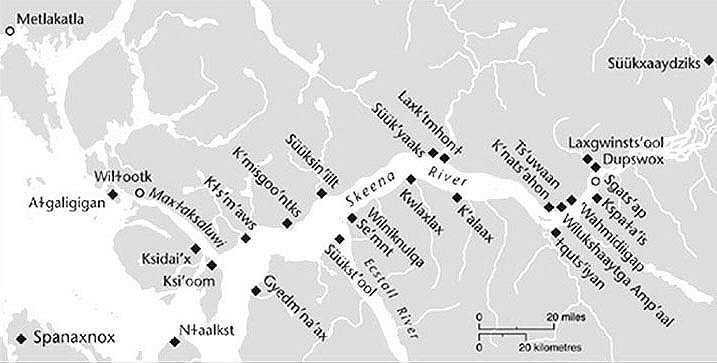S A L M O N O N T H E S K E E N A
| |||||||||||||||
| Home Page | Introduction | 7000 BC - 1790 AD | 1790 AD - 1920 AD | Credits/Contact Us | |||||||||||

|

|
|

|
|
Every tributary of the Skeena River, and many streams on the islands at its mouth, were the locations of salmon fishing sites. Each site is part of a territory owned by a specific lineage and is near the territories of the other lineages in the tribe. |
 |
While the most common sites were for rock traps, weirs, basket traps, and nets, there were also sites, such as rocky outcrops, that were ideally suited for spearing salmon. While some sites were located near villages, many of them were miles away and had to be reached by canoe. In fact, in most cases, members of each lineage moved to their fishing site for the whole summer. They transported everything they would need in their canoes in the late spring and stayed there until the fall. While they were fishing, they also picked berries and hunted certain mammals in the mountains nearby. |
|

|
|
Canoe travel was arduous: on the coast, the weather could change quickly so that travelers faced winds and high seas. On the lower Skeena River the tides made travel challenging and upriver trips required that the canoes be poled in shallow waters and sometimes pulled by rope from the shore. |
 |
|
Elsewhere were sites called Kts'mloo'lp (Place Into Salmon Rock Trap) and K'nts'iwaas (Place Where Pygmy Salmon) on Banks Island in the territory of the Kitkatla tribe of the Tsimshian, Haaytkt'iin (Standing Fish Trap) on the Shames River (a tributary of the Skeena) in the territory of the Gitando tribe, and Txalmusoo (Coming Together Sockeye) on the Ecstall River (another tributary of the Skeena) in the territory of the Gitzaxhlaahl tribe. |
|
COLLECTIONS artifacts  
|